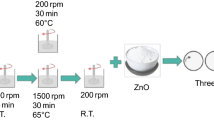Abstract
The rheological behavior of silver nanowire (AgNW) suspensions adapted for screen printing inks was investigated. Aqueous silver nanowire inks consisting of AgNW (length of 30 μm, and diameter of 40 and 90 nm), dispersant and binder were formulated. The effect of AgNW content on the rheological behavior of the ink and the build-up of ink structure after screen printing were examined as they depend on applied shear and temperature. Rheological measurements under conditions that mimic the screen printing process were done to assess viscoelastic properties induced by flow alignment of the wires and the subsequent recovery of the low shear structure. The Stretched Exponential model (SEmo) was used to model the recovery process after screen printing to obtain the characteristic time of the recovery or build-up process. The characteristic time was determined at several temperatures to obtain the activation energy of recovery. The domination of Brownian motion or non-Brownian motion behavior can be characterized by a Peclet number, which is the ratio of shear rate to the rotational diffusion coefficient. The Peclet number and the dimensionless concentration of wires were used to assess the recovery mechanism. The steady viscosity at low and high shear rates was also treated by an activation energy analysis.












Similar content being viewed by others
References
Aleeva Y, Pignataro B (2014) Recent advances in upscalable wet methods and ink formulations for printed electronics. J Mater Chem C 2:6436–6453
Barnes HA (1997) Thixotropy—a review. J Non-Newtonian Fluid Mech 70:1–33
Cassagnau P (2013) Linear viscoelasticity and dynamics of suspensions and molten polymers filled with nanoparticles of different aspect ratios. Polymer 54:4762–4775
Chandler HD (2014) An activation energy approach to analysing non-Newtonian slurry viscosities with application to a suspension of starch in a carboxymethylcellulose solution. Powder Technol 268:368–372
Ciocirlan O, Iulian O (2009) Density, viscosity and refractive index of the dimethyl sulfoxide+ o-xylene system. J Serb Chem Soc 74(3):317–329
Faddoul R, Reverdy-Bruas N, Blayo A (2012a) Formulation and screen printing of water based conductive flake silver pastes onto green ceramic tapes for electronic applications. Mater Sci Eng B 177:1053–1066
Faddoul R, Reverdy-Bruas N, Bourel J (2012b) Silver content effect on rheological and electrical properties of silver pastes. J Mater Sci 23:1415–1426
Hemmati S, Barkey DP, Gupta N, Banfield R (2015) Synthesis and characterization of silver nanowire suspensions for printable conductive media. ECS J Solid State Sci Technol 4(4):3075–3079
Litchfield DW, Baird DG (2006) The rheology of high aspect ratio nanoparticle filled liquids. Rheol Rev 1–60
Liu J, Gao Y, Cao D, Zhang L, Guo Z (2011) Nanoparticle dispersion and aggregation in polymer nanocomposites: insights from molecular dynamics simulation. Langmuir 27:7926–7933
Mallik S (2009) Study of the time-dependent rheological behavior of lead-free solder pastes and flux mediums used for flip-chip assembly applications PhD Thesis of Electronics Manufacturing Engineering Research Group School of Engineering. University of Greenwich at Medway, Kent
Mewis J, Wagner NJ (2012) Colloidal suspension rheology. Cambridge University Press, Cambridge
Quemada D (1998) Rheological modeling of complex fluids. I. The concept of effective volume fraction revisited. Eur Phys J Appl Phys 1:119–127
Willenbacher N, Georgieva K (2013) Product design and engineering: formulation of gels and pastes. Wiley, Weinheim
Yin W, Lee D-H, Choi J, Park C, Cho SM (2008) Screen printing of silver nanoparticle suspension for metal interconnects. Korean J Chem Eng 25(6):1358–1361
Zhou H, Heyer P, Kim H-J, Song J-H, Piao L, Kim S-H (2011) Reversible macroscopic alignment of Ag nanowires. Chem Mater 23:3622–3627
Acknowledgments
This work is supported by the National Science Foundation (NSF) under Grant No. CMMI-1200544.
Author information
Authors and Affiliations
Corresponding author
Electronic supplementary material
Below is the link to the electronic supplementary material.
Rights and permissions
About this article
Cite this article
Hemmati, S., Barkey, D.P. & Gupta, N. Rheological behavior of silver nanowire conductive inks during screen printing. J Nanopart Res 18, 249 (2016). https://doi.org/10.1007/s11051-016-3561-4
Received:
Accepted:
Published:
DOI: https://doi.org/10.1007/s11051-016-3561-4




